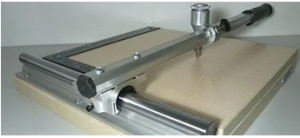Image credit: msesupplies.com
Various factors need consideration when planning to cut Laminated Safety Glass (LSG). Care is required to ensure shaped parts are of high quality and meet functional standards. This is the only way to meet the extremely high aesthetic and visual standards of the finished product. The tool and system you use play a crucial role to get the desired results.
A blunt cutting wheel or one with a wrong angle will give you poor results. It is important to have your tool in top condition and should match appropriately on interaction. Keep in mind that regular maintenance is required to cut the glass to match your laboratory requirements. Here are three essential tools to cut glass properly and professionally.
Table of Contents
Cutting wheel
A cutting wheel connects the machine and material you are cutting making it a very important accessory. The rule of thumb is to use the appropriate cutting wheel at the correct angle. Additionally, the cutting wheel needs appropriate oiling for optimal cutting. The joy of any professional glass cutter is seeing the wheel moving cleanly and neatly on the glass surface. To crush the glass requires a clean cut with a wheel in good condition.
Look for a glass cutting table for sale with automatic recording of consumption for every cutting wheel with indication when change is necessary. Depending on how fine glass is, you have to understand the features of each cut. Active (A) is for cutting standard and low glass sheets. Basic (B) is for cutting thing glass sheets and Contact Plus (CP) cuts with increased pressure for special cuts and trims.
Note:
You have to use appropriate cutting oil at an optimal cutting angle to avoid shelling-out of the scoring furrow. Glass is a type of polycrystalline liquid whose micro-fissures heal during cutting. Cutting oil is necessary to break the glass perfectly without using much force and energy.
For a clean-cut, you have to mind about cutting acceleration and speed. Thinner glass requires a more acute angle at lower pressure to get a finer cut. The thicker glass needs a more obtuse angle with higher pressure to get a coarser cut. Taking these parameters in mind leads to cut glass with smooth edges.
Crusher roller
The next step in cutting laminated safety glass is using a crusher roller. This is on the rear cutting head for crushing the glass at particular pressure on the scoring edge. The position of the crusher roller determines the glass side for crushing. When at the top, glass is crushed at the lower end while having the roller at the bottom leads to the crushing of the upper glass.
You have to mind the geometry of the crusher roller to allow precise travel on the glass crack edge. The ideal crusher rollers have optimum geometry for each use. Maintenance is essential since the rollers wear out
Foil cutting blade
The Polyvinyl butyral (PVB) foil in laminated glass requires cutting. It is a resin for applications requiring strong binding, toughness, optical clarity, flexibility, and adhesion to various surfaces. You need a foil cutting blade to cut PVB making it an essential tool for cutting glass after the cutting wheels. The ideal foil cutting blade is not too sharp but in perfect condition for a clean cut along the glass edge to prevent delamination.
A foil cutting blade in poor condition is likely to destroy the glass edge. Ensure to acquire one from a reputable company whose technical team ensures the production of blades with high durability for optimal cutting. The ideal blade is read adjustable for up to three times for re-sharpening before you get a replacement.
What makes a quality glass cutting table?
A conventional glass cutting table requires manual pressure to scratch the glass in an appropriate cutting position for a successful project. The ideal glass cutting table requires continuous quality control for peace of mind that the cutting wheels are working appropriately. You need a skilled person to master the use of this table to avoid waste after a failed project.
Poorly cut glass in inappropriate sizes is likely to create problems. A user-friendly cutting table without manual pressure is required to cut and break glass appropriately. The ideal cutting table cuts with high precision for glass 1 to 5mm thick. This table should have a rubber clamp that opens with millimetre-scaled measurements for challenging configurations.
Wrapping up
Laboratory applications need glass cut with high precision to avoid problems while undertaking further projects. So, understanding the basics of cutting laminated safety glass is essential. The steps to cut glass to match your needs include using a cutting wheel, crusher roller, and foil cutting blade. The rule of thumb is to invest in a quality glass cutting table for high precision cutting to match your project requirements.
